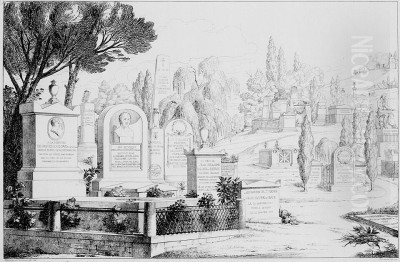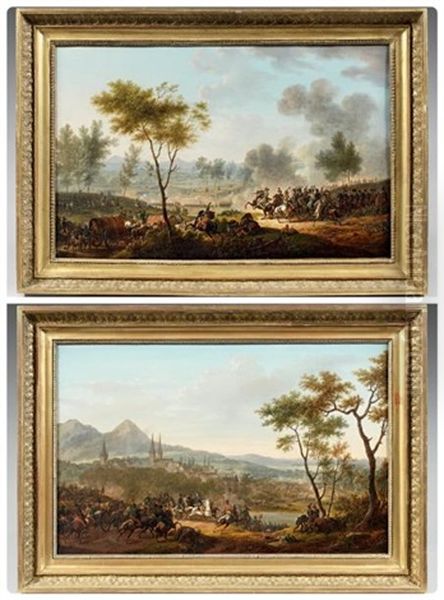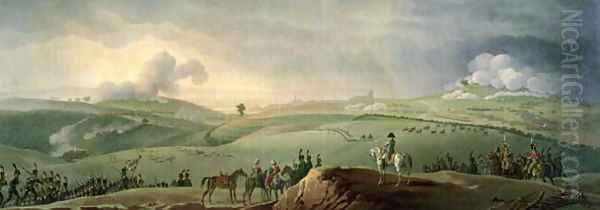
Jacques François Joseph Swebach-Desfontaines stands as a significant figure in French art during a period of profound transformation. Born in Metz in 1769 and passing away in Paris in 1823, his life and career spanned the tumultuous years of the French Revolution, the rise and fall of Napoleon Bonaparte, and the Bourbon Restoration. Primarily recognized as a painter and printmaker, Swebach-Desfontaines carved a niche for himself with his detailed and dynamic depictions of military engagements, equestrian scenes, and historical events, becoming a visual chronicler of his time.
Early Life and Artistic Formation
Born into an artistic milieu, Jacques François Joseph Swebach likely received his initial training from his father, François Louis Swebach, who was also an artist. This early exposure to the craft in his native Metz laid the foundation for his future career. Seeking broader opportunities and more advanced instruction, Swebach eventually relocated to Paris, the epicenter of the French art world.
In Paris, he further honed his skills under the tutelage of Michel Duplessis. While Duplessis may not be as widely recognized today as some other masters of the era, studying in a Parisian atelier provided Swebach with essential technical grounding and exposure to the prevailing artistic currents. This period was crucial in shaping his draftsmanship and his approach to composition, preparing him for his public debut.
Debut and Salon Career
Swebach-Desfontaines made his first significant public appearance in the art world in 1783, exhibiting at the Salon de la Correspondance. This early debut marked the beginning of a long and consistent presence in the Parisian art scene. Following the reorganisation of the official Salon during the Revolution, he became a regular exhibitor at the prestigious Louvre Salon, showcasing his works there frequently between 1791 and 1822.

Participation in the Salon was critical for an artist's career during this period. It was the primary venue for artists to gain recognition, attract patronage, and engage with critics and the public. Swebach-Desfontaines's consistent presence over three decades indicates a sustained level of production and a degree of acceptance within the official art establishment, even as artistic styles evolved dramatically around him. His submissions often featured the subjects that would define his oeuvre: horses, soldiers, and bustling historical moments.
Artistic Style: Romanticism and Precision
Swebach-Desfontaines is generally associated with the early phases of Romanticism in France, although his style retains elements of late 18th-century precision. His work is characterized by a keen attention to detail, particularly in the rendering of uniforms, equine anatomy, and the specific settings of his scenes. He possessed a remarkable ability to capture movement and energy, especially in his depictions of cavalry charges, hunts, and bustling crowds.
His paintings often exhibit a dynamic composition, filled with numerous figures engaged in various activities. While sometimes lacking the overt emotional intensity of later Romantics like Théodore Géricault or Eugène Delacroix, Swebach's work conveys the drama and chaos of battle or the lively atmosphere of social events through meticulous observation and energetic brushwork. His handling of light and shadow was praised, contributing to the clarity and vivacity of his scenes. His skill extended to watercolour and drawing, mediums well-suited to his detailed approach.
Chronicler of Conflict: Military and Historical Themes
The Napoleonic Wars provided Swebach-Desfontaines with a wealth of subject matter. He became particularly renowned for his military paintings, capturing the spectacle and sometimes the grim reality of contemporary warfare. These works ranged from specific, identifiable battles to more generic scenes of camp life, troop movements, and cavalry skirmishes. His focus was often on the collective experience of soldiers and the intricate dance of men and horses in combat.
One of his notable works in this genre is La Bataille de Marengo (The Battle of Marengo), painted around 1801. This subject, celebrating a key Napoleonic victory, was popular among artists, including Antoine-Jean Gros. Swebach's rendition likely emphasized the complex troop movements and the dramatic landscape. He also depicted other Napoleonic campaigns, such as scenes from the Russian campaign and The Passage of the Danube by Napoleon, showcasing the logistical challenges and grandeur associated with the Emperor's military endeavours. These works served not only as artistic statements but also participated in the broader visual culture celebrating, or at least documenting, the Empire's military exploits, aligning him thematically with battle painters like Horace Vernet (son of his collaborator Carle Vernet).
Scenes of Revolution and Society

Beyond the Napoleonic battlefields, Swebach-Desfontaines also turned his attention to the French Revolution itself. His work Pillage d'une église pendant la Révolution (Pillage of a Church during the Revolution), or similar scenes like the Disaffectation d'une église (Deconsecration of a Church) from 1794, directly addressed the turbulent social and political changes of the era. These paintings reflect the anti-clerical sentiment and the upheaval that characterized the period, offering a glimpse into the impact of revolutionary events on everyday life and institutions.
His oeuvre was not solely focused on conflict and upheaval. He also excelled at depicting more elegant social occasions and equestrian pursuits. Works like Course de chevaux (Horse Race and Carriage Parade) from 1800 capture the fashionable side of Parisian life, showcasing his skill in rendering horses in motion and the details of contemporary dress and carriages. These scenes place him alongside artists like Louis Léopold Boilly, who also documented the social fabric of Paris.
The Sèvres Connection
Swebach-Desfontaines's talents extended beyond canvas and paper. From 1802 to 1811, he held a significant position as a principal painter and designer (premier peintre) at the renowned Sèvres porcelain factory. This appointment underscores his reputation for detailed and refined work, suitable for the luxurious surfaces of porcelain. During his tenure, he created numerous designs, often adapting his favoured military and historical themes to the medium.
His contributions included intricate scenes decorating vases, plates, and other ceramic forms. Many of these depicted events from the Napoleonic Wars, such as L'empereur Napoléon 1er durant la campagne de Russie. Working at Sèvres placed him at the heart of Imperial artistic production, as the factory produced prestigious items for the state, diplomatic gifts, and wealthy patrons. This role likely brought him into contact, and perhaps competition, with other artists vying for Imperial favour and commissions.
Collaborations with Contemporaries
The art world of Paris during this era was interconnected, and Swebach-Desfontaines engaged in several collaborations with fellow artists. He is known to have worked with the landscape painter Georges Michel, suggesting a partnership where perhaps one artist focused on the figures and the other on the natural setting, a common practice at the time.

Further evidence of collaboration comes from his documented work with Jean-Louis Demarne, another painter known for landscapes and genre scenes, where Swebach may have contributed figures or specific elements to Demarne's compositions, or vice-versa. A notable collaborative project involved the creation of six paintings depicting Imperial Palaces, executed alongside Jean Joseph Xavier Bidauld, Carle Vernet, and Louis Léopold Boilly. Such joint efforts highlight the collegial, and sometimes commercially driven, nature of artistic practice in the period. Carle Vernet, like Swebach, was particularly known for his mastery of depicting horses.
Printmaking and Illustration
Swebach-Desfontaines was also a prolific printmaker. This aspect of his work was crucial for disseminating his images to a wider audience beyond the elite collectors who could afford paintings or Sèvres porcelain. He mastered various etching and engraving techniques, often reproducing his own paintings or creating original designs specifically for print.
His dedication to printmaking is exemplified by the publication of his Encyclopédie pittoresque, ou suite de compositions, caprices et études utiles aux artistes in 1805 (though some sources date it slightly later, e.g., 1810). This collection served as a sort of pattern book or source of inspiration, showcasing his versatility across various subjects, including landscapes, figures, animals, and architectural elements. He also contributed illustrations to the monumental Tableaux historiques de la Révolution française, a major publishing project that aimed to document the key events of the Revolution through images and text, further cementing his role as a visual historian of his time. His turn towards printmaking in later years mirrored a trend seen among other artists seeking broader reach and potentially more stable income.
International Recognition: The Russian Connection
Swebach-Desfontaines's reputation extended beyond the borders of France. His work found particular favour in Russia, where his detailed and lively scenes, especially those involving horses and military subjects, resonated with aristocratic collectors. He received patronage from high-ranking figures, reportedly including Tsar Alexander I himself, for whom he may have painted portraits or other commissions.
His paintings were exhibited in St. Petersburg, and he gained considerable acclaim within Russian art circles. He was sometimes referred to as "the Wouwerman of our time," a significant compliment comparing him to the celebrated 17th-century Dutch Golden Age painter Philips Wouwerman, who was renowned for his mastery of depicting horses, battles, and landscapes, often on a small, detailed scale. This comparison highlights the specific qualities for which Swebach was admired: his technical finesse, his skill with equestrian subjects, and his ability to create intricate, engaging scenes.
Reputation, Criticism, and Legacy
Throughout his career, Swebach-Desfontaines enjoyed considerable success and recognition. His regular Salon participation, his prestigious role at Sèvres, and his international acclaim, particularly in Russia, attest to his standing. He successfully navigated the shifting political landscapes, finding patronage under the Directory, the Consulate, the Empire, and likely the Restoration. His ability to capture the dynamism of horses and the intricacies of military life secured his reputation.
However, his work was not without its critics. One contemporary comment described him as "the smallest and swiftest painter of the Empire." While potentially intended as praise for his speed and meticulous detail (often on relatively small canvases), it could also carry a subtle implication of lacking the grandeur or profound depth associated with the leading history painters of the era, such as Jacques-Louis David, whose Neoclassical style dominated French art for decades, or the more emotionally charged works of his Romantic contemporaries like Gros or Géricault.
Despite any criticisms, Jacques François Joseph Swebach-Desfontaines remains an important artist of his generation. He excelled in capturing the visual texture of a transformative period in French and European history. His focus on military life, equestrian skill, and contemporary events, rendered with detailed precision and lively energy, provides invaluable insight into the era. His work bridges the gap between the detailed genre painting of the 18th century and the emerging Romantic fascination with history, movement, and drama, leaving behind a rich visual record of the world he inhabited. His influence can be seen in the tradition of French military and equestrian painting that continued throughout the 19th century.